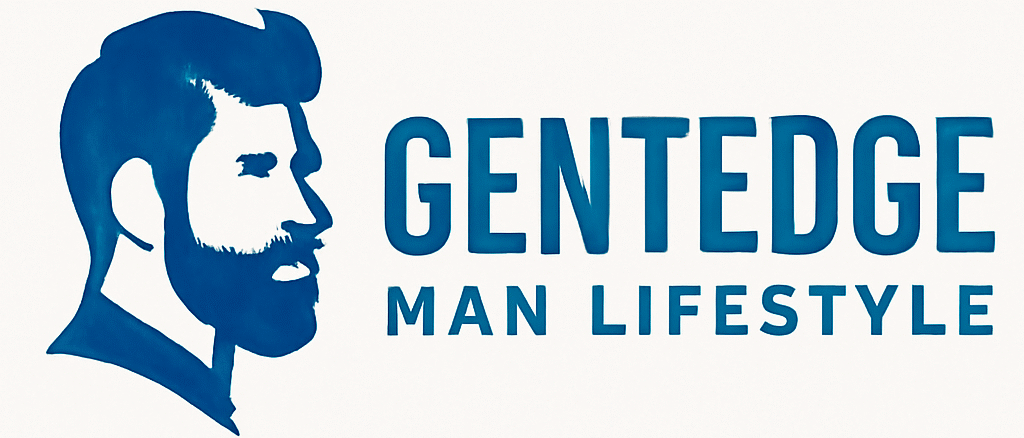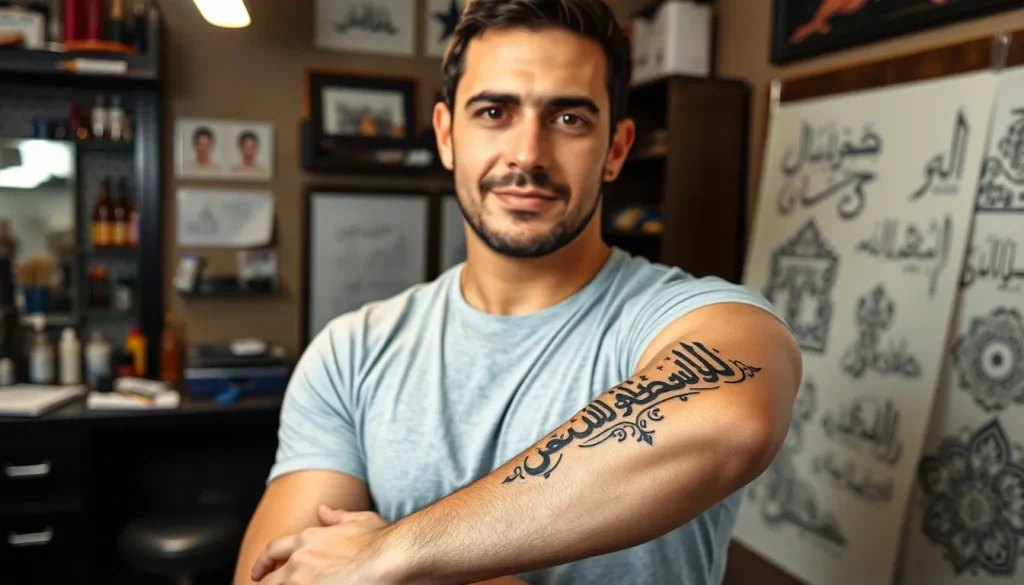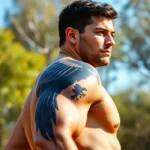Arabic tattoos have become increasingly popular among men seeking meaningful body art that combines stunning visual appeal with deep cultural significance. These intricate designs offer a perfect blend of artistic beauty and spiritual meaning that resonates with men from all backgrounds.
We’ve witnessed a remarkable surge in Arabic tattoo requests as more men discover the elegance of Arabic calligraphy and its powerful symbolism. From bold verses that represent strength and courage to delicate script that honors family and faith, Arabic designs provide endless possibilities for personal expression. The flowing lines and geometric patterns create visually striking tattoos that stand out in any collection.
Whether you’re drawn to traditional Islamic calligraphy, modern Arabic fonts, or symbolic phrases that reflect your values, we’ll guide you through the most compelling Arabic tattoo designs specifically curated for men. These timeless pieces aren’t just tattoos – they’re statements of identity that carry profound meaning while showcasing exceptional artistry.
Traditional Arabic Calligraphy Tattoo Designs for Men
Traditional Arabic calligraphy forms the foundation of meaningful masculine tattoo artistry. We’ve observed how these time-honored scripts transform personal beliefs and cultural heritage into powerful body art statements.
Classic Kufic Script Styles
Kufic script delivers the most striking visual impact for men seeking bold Arabic tattoos. This angular calligraphy style originated in the 7th century and features geometric shapes that create dramatic masculine aesthetics. We recommend Kufic designs for chest pieces, shoulder blades, and forearm placements where the script’s bold lines can make maximum visual impact.
Modern interpretations of Kufic script incorporate decorative elements like interlacing patterns and ornamental borders. These enhanced versions work exceptionally well for larger tattoo pieces spanning across the back or wrapping around the upper arm. Square Kufic variations offer contemporary appeal while maintaining traditional authenticity.
Popular Kufic tattoo phrases include “La ilaha illa Allah” (There is no god but Allah) and personal names rendered in this powerful script. The geometric nature of Kufic lettering allows tattoo artists to create symmetrical designs that complement masculine body contours.
Thuluth Script Variations
Thuluth script represents the pinnacle of Arabic calligraphic elegance for sophisticated tattoo designs. This flowing script style features elongated vertical strokes and graceful curves that create visually stunning masculine body art. We’ve seen Thuluth tattoos gain popularity among men who appreciate refined artistic expression.
Traditional Thuluth designs work beautifully for religious verses, poetry, and meaningful quotes. The script’s inherent flexibility allows tattoo artists to adapt letter proportions for various body placements. Ribcage tattoos particularly showcase Thuluth’s flowing characteristics.
Contemporary Thuluth variations incorporate shadow effects and dimensional shading techniques. These modern adaptations enhance the script’s natural beauty while maintaining its classical proportions. Men often choose Thuluth script for Quranic verses like “Bismillah” or personal mantras that reflect their spiritual journey.
Naskh Script Options
Naskh script offers the most readable and versatile option for Arabic tattoo enthusiasts. This clear, proportioned calligraphy style balances traditional authenticity with modern accessibility. We recommend Naskh designs for men wanting legible Arabic text that maintains cultural significance.
Standard Naskh tattoos excel in smaller placements like wrists, behind the ear, or along the collarbone. The script’s clarity ensures that meaningful words and phrases remain distinguishable even in compact tattoo formats. Popular choices include family names, birth dates in Arabic numerals, and short inspirational phrases.
Ornamental Naskh variations incorporate decorative dots, flourishes, and connecting elements that enhance visual appeal. These embellished versions suit larger tattoo pieces while preserving the script’s fundamental readability. Men frequently select ornamental Naskh for meaningful Arabic proverbs and extended quotations that require clear presentation.
Popular Arabic Phrases and Quotes for Male Tattoos

We’ll explore meaningful Arabic phrases that resonate with men seeking powerful tattoo designs. These expressions carry deep cultural significance and translate beautifully into striking body art.
Religious and Spiritual Sayings
“بسم الله” (Bismillah) stands as one of the most revered Arabic phrases for male tattoos. This sacred expression means “In the name of God” and represents unwavering faith and devotion in Islamic culture.
“إِنَّ مَعَ الْعُسْرِ يُسْرًا” (Inna ma’al-usri yusra) offers profound spiritual comfort through its Quranic origins. The phrase translates to “Indeed, with every hardship comes ease” and serves as a reminder of divine support during challenging times.
“الله أكبر” (Allahu Akbar) carries immense spiritual weight meaning “God is greatest.” Men often choose this phrase to express their religious commitment and acknowledge divine supremacy in their lives.
“لا إله إلا الله” (La ilaha illa Allah) represents the fundamental declaration of Islamic faith. This powerful statement means “There is no god but Allah” and works exceptionally well in bold Kufic script placements.
Motivational and Inspirational Quotes
“مقاتل” (Muqatil) embodies strength and determination with its meaning “Fighter.” We recommend this single word for men who’ve overcome important life challenges and want to showcase their resilient spirit.
“الصبر مفتاح الفرج” (As-sabr miftah al-faraj) delivers timeless wisdom through its translation “Patience is the key to relief.” This phrase resonates with men who understand that perseverance leads to success and breakthrough moments.
“قوي” (Qawi) simply means “Strong” and creates an impactful tattoo statement. The word’s bold letters translate beautifully into masculine tattoo designs across various body placements.
“النصر قريب” (An-nasr qareeb) inspires hope with its meaning “Victory is near.” Men facing ongoing struggles often choose this phrase to remind themselves that success awaits those who persist.
Family and Love Expressions
“أنا لست بمفرد” (Ana lastu bi-mufarad) creates emotional connection through its translation “I am not alone.” This phrase symbolizes unity, family support, and the bonds that sustain us through life’s journey.
“أحبك” (Ahabuk) offers a simple yet powerful expression meaning “I love you.” We see many men choosing this phrase to honor their romantic partners, children, or family members permanently.
“عائلة” (A’ila) represents the Arabic word for “Family” and serves as a tribute to blood bonds. This single word tattoo works beautifully in elegant Thuluth script to honor familial connections.
“ابني” (Ibni) means “My son” and creates deeply personal father child tattoos. Men often pair this phrase with birth dates or names to commemorate their paternal relationships and responsibilities.
Modern Arabic Typography Tattoo Styles for Men
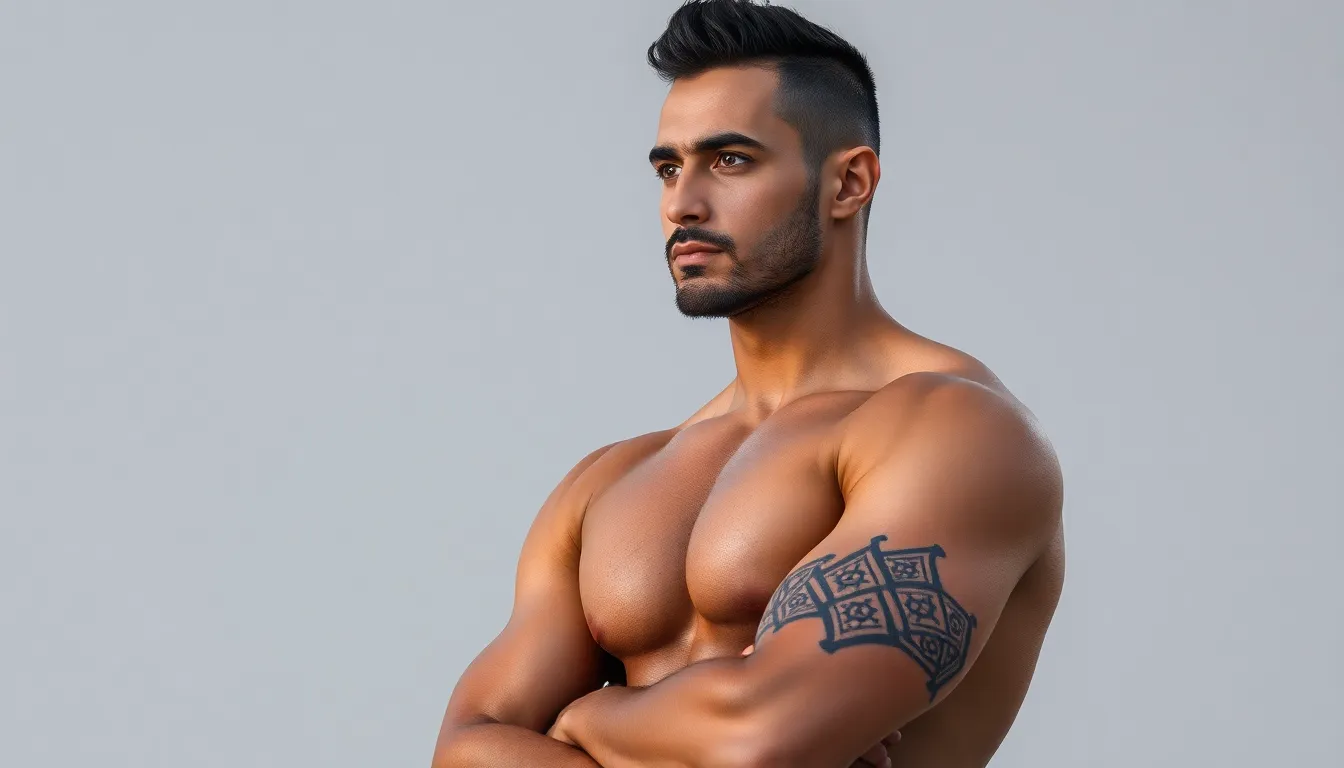
We’re witnessing an exciting evolution in Arabic tattoo artistry as contemporary designers blend traditional scripts with modern aesthetics. These innovative approaches create striking masculine designs that honor cultural heritage while embracing fresh artistic perspectives.
Contemporary Fusion Designs
Cultural blending transforms Arabic typography by incorporating elements from Japanese, Western, and other artistic traditions into cohesive masculine designs. Artists combine Arabic calligraphy with tribal patterns, creating powerful chest pieces that speak to men from diverse backgrounds. Digital enhancements elevate traditional scripts through modern technology, adding shadow effects, 3D depth, and gradient coloring that makes Arabic text appear to leap from the skin.
Abstract incorporations merge Arabic letters with geometric shapes, flowing watercolor backgrounds, or mechanical elements for men who appreciate avant-garde artistry. These fusion designs often feature popular phrases like “Sabr” (patience) intertwined with Celtic knots or Polynesian motifs, creating unique cultural conversations on the body.
Geometric Arabic Letter Combinations
Geometric patterns transform Arabic typography into architectural masterpieces perfect for masculine shoulders and forearms. Designers combine letters with chevron patterns, Islamic geometric tiles, and mosaic elements that create visually striking symmetrical compositions. Balance and symmetry define these designs, reflecting the mathematical precision found in traditional Islamic art while maintaining modern appeal.
Sacred geometry influences many of these combinations, where Arabic phrases like “Tawakkul” (trust in God) integrate seamlessly with hexagonal patterns, star formations, and intricate lattework. These designs often span larger canvas areas like the back or chest, allowing for complex mathematical relationships between text and pattern.
Minimalist Arabic Text Approaches
Simple script focuses on clean, unadorned Arabic lettering that emphasizes meaning over ornamental complexity. Men choosing minimalist approaches often select single powerful words like “Habibi” (my love) or “Quwwa” (strength) rendered in elegant, straightforward calligraphy. Subtle placement characterizes these designs, with discrete positioning on wrists, behind ears, or along the collarbone for personal significance without overwhelming visual impact.
Clean lines define minimalist Arabic tattoos, using negative space effectively to create breathing room around each letter. These designs prove that simplicity doesn’t diminish cultural significance, as even the most understated Arabic script carries profound meaning for the wearer.
Placement Ideas for Arabic Tattoo Designs on Men

Choosing the right placement transforms your Arabic tattoo from artwork into a powerful statement. We’ll explore the most effective body locations that complement masculine aesthetics while honoring Arabic cultural traditions.
Forearm and Wrist Positioning
Forearms offer exceptional visibility for your Arabic calligraphy while providing enough space for meaningful phrases. This location works particularly well for medium-length quotes or verses that you want to display prominently in professional and social settings.
Wrist placements create intimate connections with shorter Arabic words or symbols that hold personal significance. We recommend this area for names, single words like “Sabr” (patience), or brief phrases that serve as daily reminders of your values.
Consider the natural curve of your forearm when selecting script styles, as flowing Thuluth calligraphy follows the arm’s contours beautifully. Bold Kufic designs also work exceptionally well on the outer forearm, creating striking geometric patterns that catch attention.
Chest and Shoulder Locations
Chest positioning provides the largest canvas for elaborate Arabic designs, making it perfect for longer verses or complex calligraphic compositions. This central location symbolizes keeping meaningful words close to your heart, which resonates deeply with Arabic cultural values.
Shoulder placements offer versatility for both small and medium-sized designs while maintaining professional discretion when needed. The rounded shoulder surface works well for circular Arabic phrases or designs that incorporate geometric elements around the text.
We’ve found that chest tattoos work best with horizontal Arabic text that spans across the pectoral area, while shoulder designs benefit from vertical or curved arrangements that follow the muscle’s natural shape.
Back and Spine Arrangements
Back locations provide unlimited space for the most elaborate and detailed Arabic tattoo designs. This expansive area allows for intricate calligraphy combined with geometric patterns, architectural elements, or nature-inspired motifs that complement the Arabic text.
Spine placements create dramatic vertical compositions perfect for longer Arabic phrases or verses. These designs often incorporate the spine’s natural line as part of the overall aesthetic, creating powerful visual statements about strength and spiritual alignment.
Upper back positioning between the shoulder blades works exceptionally well for Arabic warrior-themed designs that emphasize cultural heritage and masculine strength. This location allows for bold, detailed artwork that can include Arabic text alongside symbolic imagery like traditional weapons or geometric armor patterns.
Arabic Symbol and Ornamental Tattoo Patterns
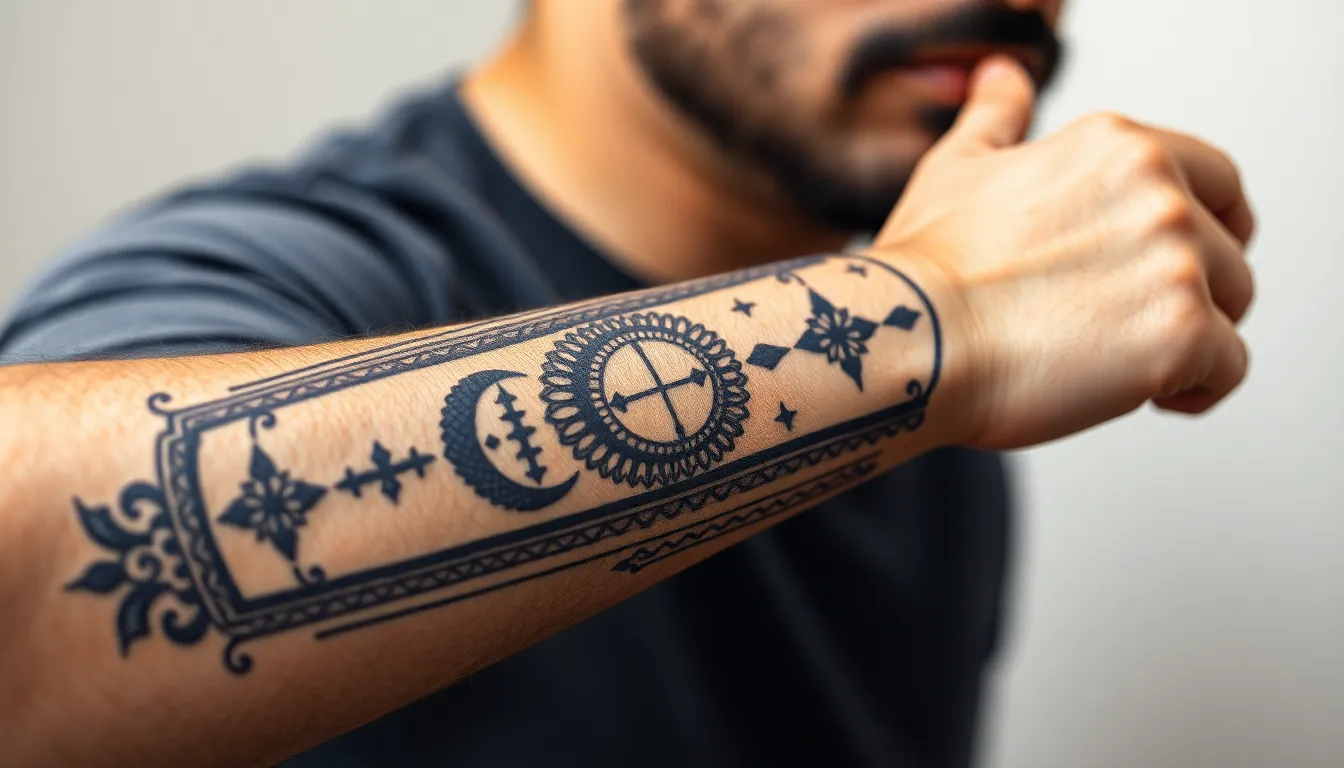
We explore how ornamental patterns and cultural symbols elevate Arabic tattoos beyond simple text. These decorative elements transform basic script into elaborate artistic compositions that honor Islamic heritage.
Traditional Islamic Geometric Designs
Traditional Islamic geometric patterns create mathematically precise tattoo designs that reflect spiritual balance and architectural beauty. Stars and polygons interlock in symmetrical arrangements, forming the foundation of these stunning visual compositions. These patterns draw inspiration directly from Islamic architecture, where mathematical harmony represents divine order and perfection.
Interlacing star motifs work exceptionally well for larger tattoo placements like shoulder pieces and back designs. Eight-pointed stars, twelve-pointed stars, and hexagonal patterns create mesmerizing optical effects when combined with Arabic calligraphy. The geometric precision mirrors the mathematical traditions found in historical mosques and palaces.
Polygonal arrangements offer versatility for different body areas and can be scaled to complement existing Arabic text tattoos. Triangular tessellations, square grids, and hexagonal honeycombs provide structured backgrounds that frame meaningful Arabic phrases beautifully. These patterns maintain their visual impact whether rendered in bold black lines or subtle dotwork techniques.
Arabic Decorative Border Elements
Arabesque border patterns frame Arabic tattoos with intricate floral and vine motifs that enhance the overall composition. These decorative elements consist of flowing botanical designs, curved geometric patterns, and interwoven scrollwork that creates elegant boundaries around central text or symbols.
Floral arabesque borders incorporate stylized roses, lotus petals, and vine tendrils that complement masculine Arabic script designs. These patterns can wrap around forearms, encircle shoulder pieces, or create decorative frames for chest tattoos. The organic curves provide beautiful contrast to the angular nature of Arabic calligraphy.
Geometric arabesque elements feature repeating diamond shapes, curved lines, and interlocking circles that create sophisticated border treatments. These patterns work particularly well for ribcage tattoos and back pieces where longer compositions benefit from structured framing. The borders add visual weight and completion to any Arabic tattoo design.
Cultural Symbol Integration
The crescent moon (الهلال) symbolizes growth and renewal in Arabic tattoo compositions, often paired with meaningful script or geometric patterns. This powerful symbol represents the cyclical nature of life and Islamic heritage, making it particularly popular for men seeking tattoos that reflect spiritual growth and new beginnings.
The lotus flower (زهرة اللوتس) represents resilience and spiritual awakening when integrated into Arabic designs. Men choose this symbol to complement motivational phrases like “مقاتل” (fighter) or protective verses, creating layered meanings within their tattoo compositions. The lotus pairs beautifully with flowing Thuluth script and geometric borders.
The protective eye (العين) offers symbolic protection and strength in Arabic tattoo artistry, frequently combined with phrases about courage and perseverance. This ancient symbol integrates seamlessly with both traditional Kufic lettering and modern geometric patterns, creating powerful masculine designs that carry deep cultural significance.
Name and Personal Word Arabic Tattoos for Men

Personal names and meaningful words in Arabic script create some of the most intimate and powerful tattoo designs for men. We’ve found that these personalized tattoos allow men to carry their identity, values, and loved ones with them in beautiful Arabic calligraphy.
Converting English Names to Arabic Script
Converting your English name into Arabic script requires careful transliteration to ensure accurate pronunciation and meaning. We recommend consulting with Arabic linguists or using specialized online tools that properly map English sounds to Arabic characters. Professional transliteration services guarantee that your name maintains its phonetic integrity when written in Arabic script.
English names often adapt beautifully to Arabic calligraphy styles like Thuluth or Naskh. Michael becomes مايكل (Maaykil), while James transforms into جيمس (Jeems). We suggest testing different calligraphy styles to see which best complements your name’s natural flow and character count.
Important Personal Words Translation
Strength translates to قوة (Quwwah), making it a popular choice for men seeking to embody power and resilience in their tattoos. We’ve observed that meaningful words like مقاتل (Muqatil), meaning “Fighter,” resonate strongly with men who’ve overcome challenges or serve in demanding professions.
Courage becomes شجاعة (Shuja’ah) in Arabic script, while فنان (Fanaan) meaning “Artist” appeals to creative individuals. These single-word translations work exceptionally well in minimalist designs or as focal points in larger compositions. We recommend choosing words that reflect your core values or life experiences for maximum personal significance.
Family translates to عائلة (A’ilah), representing the foundation of many men’s lives and values.
Family Member Name Combinations
Combining family members’ names creates deeply personal tattoo designs that honor your most important relationships. We often see fathers incorporating their children’s names alongside their own, creating unified Arabic script compositions that flow seamlessly together.
Brother combinations work particularly well when using consistent calligraphy styles across all names. We suggest arranging family names vertically along the spine or horizontally across the chest to create balanced, meaningful designs. Father and son name pairings, for example, can be elegantly intertwined using flowing Thuluth script.
Multiple family member names require careful spacing and sizing to maintain readability while creating visual harmony. We recommend limiting combinations to three or four names maximum to preserve the elegance and clarity of each individual name within the overall design.
Size and Scale Considerations for Arabic Tattoo Designs
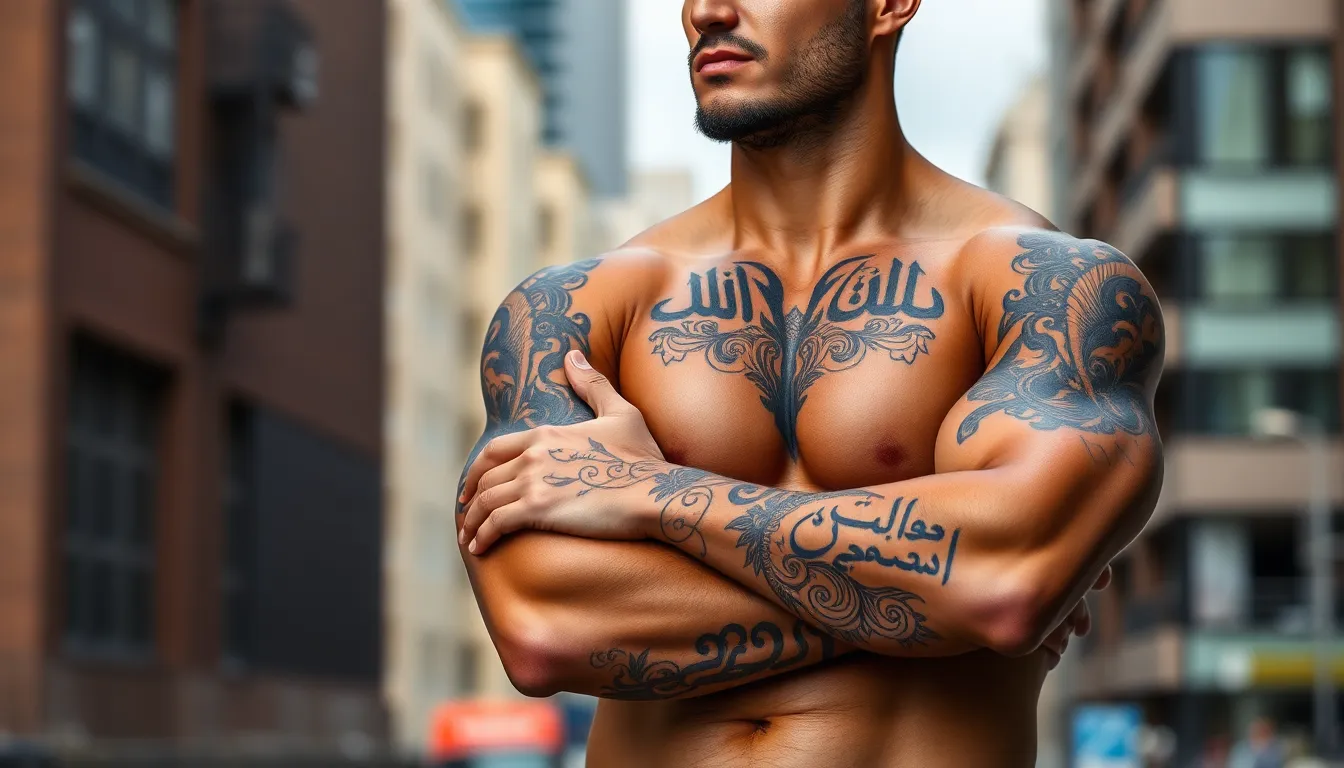
Choosing the right size for your Arabic tattoo directly impacts its readability and visual impact. Arabic script’s intricate details require careful consideration of scale to maintain both aesthetic appeal and cultural respect.
Large Statement Piece Options
Back placements offer the broadest canvas for complex Arabic phrases and full quotes, accommodating detailed calligraphy that maintains script clarity. We recommend this area for elaborate compositions that combine multiple verses or integrate ornamental patterns with extended text.
Chest tattoos create bold, visible statements with ample space for large words or symbolic imagery that commands attention. The flat surface allows Arabic calligraphy to flow naturally while providing enough room for decorative border elements.
Thigh and sleeve designs accommodate extended script arrangements with ornate borders or integration with complementary tattoo elements. These locations work exceptionally well for geometric Arabic letter combinations that transform into architectural masterpieces across the larger body area.
Medium-Sized Balanced Designs
Inner arm placements suit short phrases or names perfectly, balancing visibility with subtlety for everyday wear. This location offers flexibility for displaying or concealing your Arabic tattoo based on clothing choices and social situations.
Forearm tattoos remain popular for medium-length quotes or single words with clear script that maintains readability. The natural curve of the forearm complements flowing Thuluth designs while providing sufficient space for proper letter spacing.
Side and ribcage areas fit medium designs that can be partially concealed, offering privacy when needed while allowing for personal expression. These placements work well for meaningful verses that hold intimate significance for the wearer.
Small Discrete Arabic Tattoos
Wrist tattoos prove ideal for short words, initials, or symbols that can be easily covered or displayed as desired. The limited space requires careful selection of concise phrases or single meaningful words that maintain their impact even though the smaller scale.
Neck placements on the side or back provide subtle spots for minimalistic designs, offering a personal touch without overt visibility. These locations work best with simplified Arabic script that remains legible at smaller sizes.
Finger and hand tattoos restrict designs to single letters or very brief words due to limited space and skin texture considerations. We recommend consulting with experienced artists who understand how Arabic letters adapt to these challenging placement areas.
Color Schemes and Artistic Styles for Arabic Tattoos

Color choices and artistic approaches significantly impact the visual appeal and cultural authenticity of Arabic tattoos. We’ll explore three distinct styling methods that complement the inherent beauty of Arabic script.
Traditional Black Ink Approaches
Traditional black ink remains the gold standard for Arabic tattoo designs, emphasizing the script’s natural elegance and timeless appeal. Black ink creates striking contrast against all skin tones while preserving the authenticity of traditional Arabic calligraphy. We recommend this approach for men who want their tattoos to highlight the pure beauty of the Arabic script without distractions.
Bold black lines work exceptionally well with geometric Kufic script, creating powerful statements on chest pieces and upper arms. Solid black ink ensures maximum readability for meaningful phrases like “مقاتل” (fighter) or religious verses. Classic applications include prayer quotes and family names where clarity takes precedence over decorative elements.
Fine line black work suits delicate Thuluth and Naskh scripts, particularly for smaller placements on wrists and forearms. Traditional approaches focus on consistent line weight and precise letter formation. We’ve observed that black ink Arabic tattoos age gracefully while maintaining their cultural significance throughout the years.
Modern Color Integration Methods
Contemporary Arabic tattoos incorporate strategic color placement to enhance visual impact while respecting the script’s traditional foundations. Color integration involves adding accent hues to exact elements rather than overwhelming the entire design. We suggest using colors that complement your skin tone and personal aesthetic preferences.
Deep blues and emerald greens work beautifully with Arabic script, creating sophisticated designs that honor Middle Eastern artistic traditions. Gold and copper accents can highlight exact words or decorative elements within larger compositions. Modern approaches often feature gradient transitions between colors for smooth visual flow.
Strategic color placement focuses on improving readability rather than obscuring the script’s natural beauty. Backgrounds can feature subtle color washes while keeping the text in traditional black. We recommend consulting with artists experienced in Arabic calligraphy to ensure color choices enhance rather than compete with the script’s elegance.
Artistic Shading and Gradient Techniques
Advanced shading techniques add remarkable depth and dimension to Arabic tattoo designs without compromising their cultural authenticity. Gradient applications can create three dimensional effects that make letters appear to float above the skin. We’ve seen stunning results when shading follows the natural curves of Arabic letterforms.
Drop shadow effects create visual separation between script elements and background designs or skin. Subtle gradients within individual letters can emphasize the flowing nature of scripts like Thuluth. Professional artists use shading to guide the eye through complex compositions featuring multiple phrases or decorative elements.
Artistic gradient techniques work particularly well with larger Arabic tattoo pieces on backs and chests where there’s sufficient space for detailed work. Soft transitions between light and dark areas can create sophisticated depth without overwhelming the script’s inherent beauty. We recommend these techniques for men seeking contemporary interpretations of traditional Arabic calligraphy.
Cultural Significance and Respect in Arabic Tattoo Design
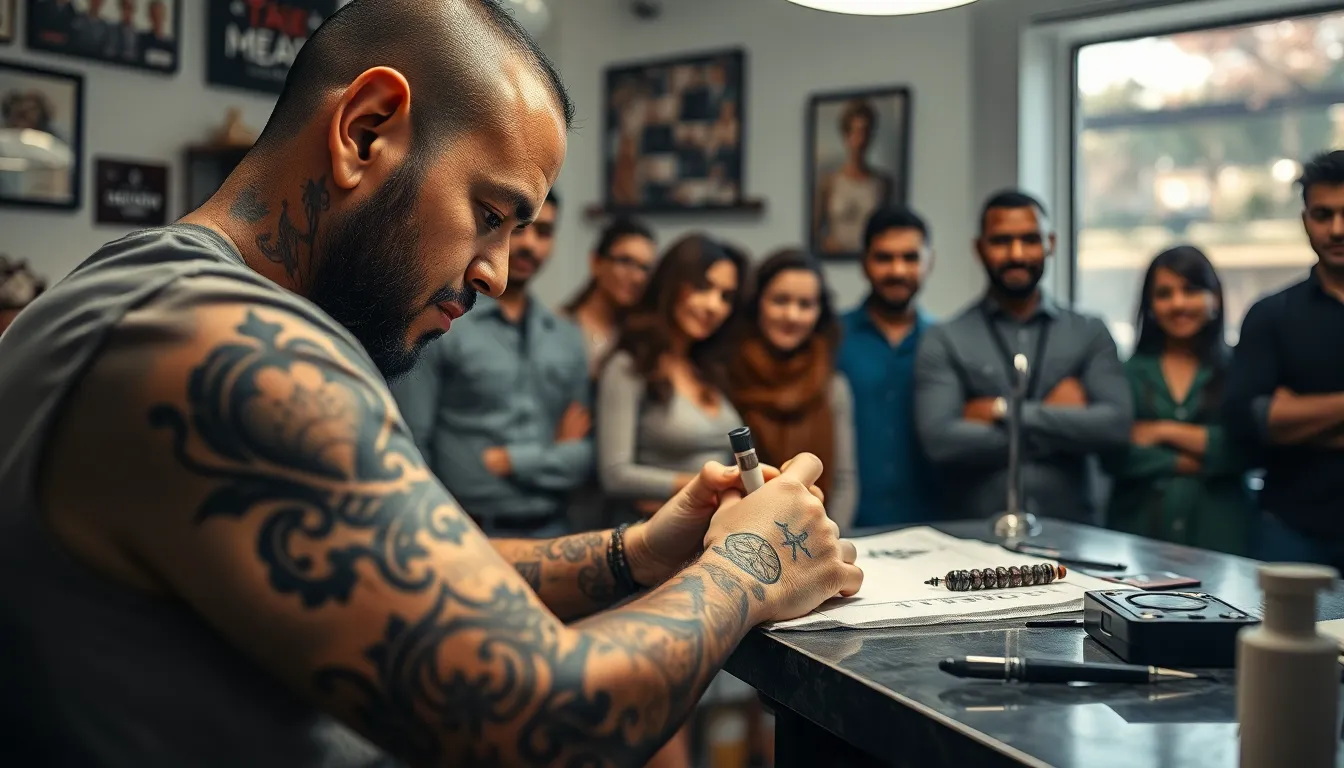
Arabic tattoos carry profound cultural weight that extends far beyond their aesthetic appeal. We must approach these designs with genuine respect and understanding to honor their rich heritage.
Understanding Sacred Text Considerations
Sacred texts require careful consideration when choosing Arabic tattoo designs. We strongly advise against using verses from the Quran or other holy texts, as these are considered sacred and their use in tattoos can be perceived as deeply disrespectful within Islamic tradition. Religious scholars and Islamic communities often view permanent body art featuring sacred scripture as inappropriate, regardless of the wearer’s intentions.
Consulting with knowledgeable individuals becomes essential before finalizing any Arabic design. We recommend speaking with Islamic scholars or cultural experts who can guide you away from potentially offensive content. Many tattoo enthusiasts unknowingly select verses or phrases that carry religious significance, making professional consultation a crucial step in the design process.
Alternative approaches focus on meaningful non-religious phrases that still honor Arabic culture. Words like مقاتل (Muqatil), meaning fighter, offer powerful symbolism for those who’ve overcome personal challenges without venturing into sacred territory. We can create impactful designs using poetry, philosophical quotes, or personal mantras that respect cultural boundaries.
Avoiding Offensive or Inappropriate Content
Blasphemous phrases or symbols must be completely avoided when selecting Arabic tattoo designs. We need to understand that certain combinations of words or religious references can be interpreted as offensive, even when the intent is respectful. Popular culture sometimes misrepresents Arabic phrases, leading to designs that carry unintended negative connotations.
Cultural sensitivity extends beyond obvious religious content to include political statements and controversial phrases. We should research the historical context of any Arabic text before committing to a permanent design. Some phrases that seem neutral in translation may carry political or sectarian implications within Arabic-speaking communities.
Professional translation services provide accuracy that prevents embarrassing mistakes. We’ve seen countless examples of poorly translated tattoos that say something entirely different from what the wearer intended. Machine translations often miss cultural nuances and contextual meanings that native speakers immediately recognize.
Honoring Arabic Heritage Properly
Symbolic designs offer respectful ways to celebrate Arabic culture without appropriating sacred elements. We can incorporate traditional symbols like the crescent moon or lotus flower to add cultural depth while maintaining appropriate boundaries. These symbols carry positive meanings across Arabic cultures and complement calligraphic elements beautifully.
Meaningful phrases that reflect universal values provide excellent alternatives to religious content. Expressions like “وما النصر إلا صبر ساعة” (Victory is but an hour of patience) honor Arabic literary tradition while conveying powerful personal messages. We can draw from centuries of Arabic poetry and philosophy to find phrases that resonate with individual experiences.
Collaboration with Arabic calligraphers ensures authentic representation of the script’s artistic heritage. We benefit from working with artists who understand the proper proportions, flow, and cultural context of different calligraphic styles. Their expertise helps create designs that genuinely honor Arabic artistic traditions rather than simply copying foreign scripts.
Choosing the Right Tattoo Artist for Arabic Designs
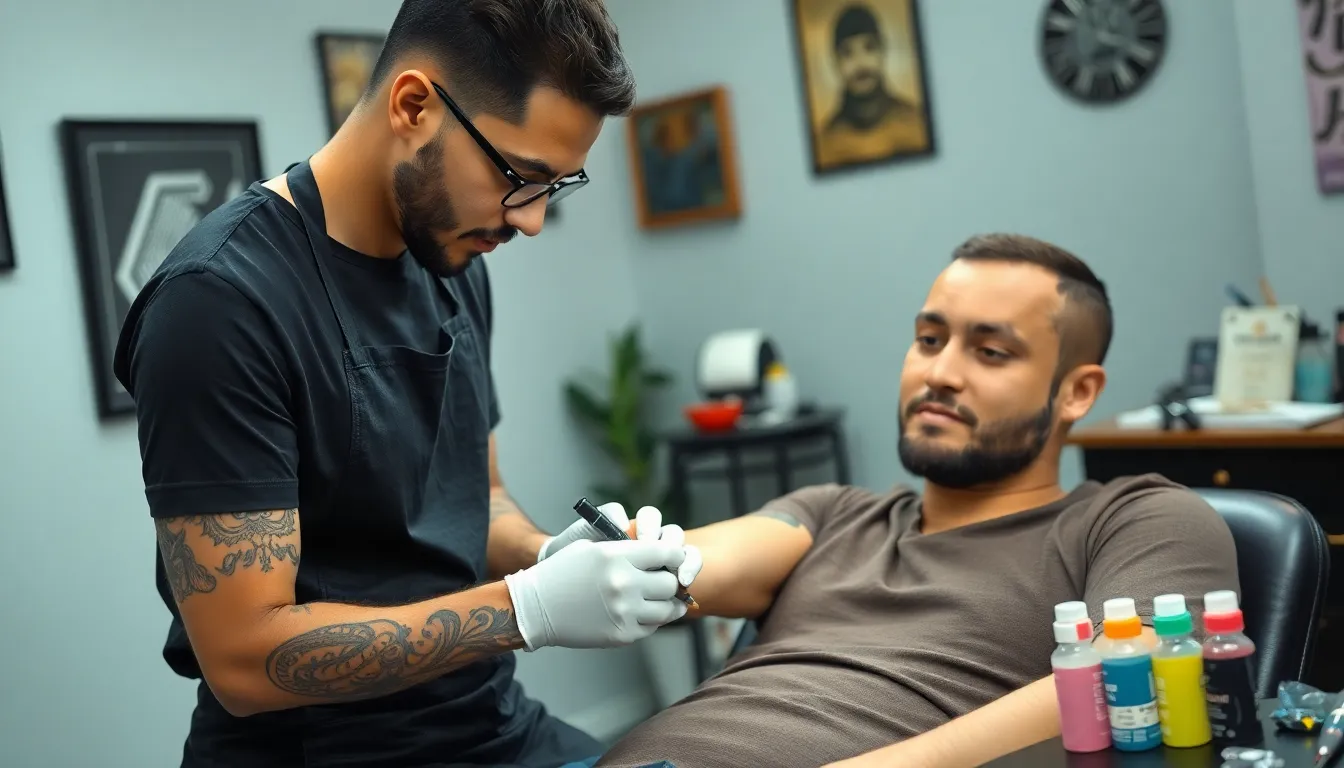
Selecting the perfect artist for your Arabic tattoo requires careful consideration of their specialized skills and cultural understanding. We’ll guide you through the essential steps to find an artist who can bring your vision to life with precision and respect.
Finding Artists with Arabic Script Experience
Research artists who specialize in Arabic calligraphy tattoos through online portfolios and social media platforms. Many talented tattoo artists showcase their Arabic script work on Instagram and specialized tattoo websites, making it easier to identify those with genuine expertise.
Look for artists with Middle Eastern heritage or formal training in Arabic calligraphy, as they often possess deeper cultural understanding and technical skill. These artists typically demonstrate superior knowledge of proper letter connections and traditional script proportions.
Check for certifications or workshops the artist has attended related to Arabic script or Islamic art. Professional development in these areas indicates serious commitment to mastering the intricacies of Arabic letterforms.
Ask about their experience with different Arabic scripts like Kufic, Thuluth, and Naskh to ensure they can execute your preferred style. Artists familiar with multiple scripts offer greater flexibility in design options and can recommend the best style for your exact tattoo concept.
Portfolio Review and Consultation Tips
Examine at least 10-15 examples of the artist’s previous Arabic tattoo work to assess consistency and quality. Look specifically for clean lines, proper letter spacing, and accurate character formation in their completed pieces.
Schedule an in-person consultation to discuss your design ideas and gauge the artist’s understanding of Arabic script nuances. During this meeting, pay attention to how they respond to questions about letter accuracy and cultural sensitivity.
Bring reference materials including your desired text written in proper Arabic script to ensure clear communication. We recommend having multiple examples of your chosen phrase or word from different sources to verify accuracy.
Request to see the artist’s sketch process and ask them to demonstrate their approach to Arabic letterforms. This reveals their working knowledge and helps you understand their design methodology.
Discuss placement options and how different body areas might affect the readability and aesthetic appeal of Arabic script. Experienced artists can provide valuable insights about scaling and positioning for optimal visual impact.
Communication and Design Approval Process
Establish clear expectations about design accuracy and cultural appropriateness from the beginning of your consultation. We strongly recommend discussing any concerns about religious or cultural sensitivity to avoid potential issues.
Request multiple design drafts before finalizing your tattoo to ensure the Arabic script meets your expectations. This iterative process allows for refinements and helps prevent costly mistakes or regrettable outcomes.
Insist on written verification of your tattoo’s meaning and translation before the tattooing process begins. Many artists work with Arabic language consultants to double-check accuracy and cultural appropriateness.
Ask for a detailed explanation of each letter and its connection to adjacent characters in your design. This demonstrates the artist’s understanding and gives you confidence in their technical abilities.
Create a feedback timeline that allows for design revisions and approvals at each stage of the process. We suggest allowing at least one week between initial design presentation and final approval to ensure thoughtful consideration.
Document the approved design with photos and written descriptions to maintain consistency during the actual tattooing session. This prevents miscommunication and ensures the final result matches your expectations.
Conclusion
Arabic tattoo designs offer men a powerful way to express their identity through culturally rich and visually stunning body art. We’ve explored everything from traditional calligraphy styles to modern typography approaches that can transform your skin into a canvas of meaningful expression.
The key to success lies in respecting the cultural significance while working with skilled artists who understand Arabic script’s nuances. Whether you’re drawn to bold geometric patterns or delicate personal inscriptions the options are limitless when approached thoughtfully.
Remember that these tattoos carry deep cultural weight so take time to research meanings and consult experts before committing. With proper planning and respect for Arabic heritage you’ll create a tattoo that’s both personally meaningful and artistically exceptional.
Your Arabic tattoo journey starts with understanding ends with a masterpiece that honors both your story and this beautiful linguistic tradition.
Frequently Asked Questions
What are the most popular Arabic calligraphy styles for men’s tattoos?
The three main Arabic calligraphy styles for men’s tattoos are Kufic, Thuluth, and Naskh. Kufic script features bold, geometric designs perfect for larger placements like chest and forearms. Thuluth offers elegant, flowing lines ideal for religious verses and ribcage tattoos. Naskh provides clear, versatile lettering suitable for smaller tattoos and family names.
Where is the best placement for Arabic tattoos on men?
Popular placements include forearms and wrists for visibility and intimacy, chest and shoulders for larger elaborate designs, and back and spine for dramatic compositions. The placement should complement the script style and size while considering the tattoo’s cultural significance and personal meaning.
What Arabic phrases are commonly used in men’s tattoos?
Popular phrases include religious expressions like “Bismillah” (In the name of God) and “Allahu Akbar” (God is greatest), motivational words like “Muqatil” (Fighter), and family-oriented terms like “Ibni” (My son). Personal attributes like “Strength” (قوة) and “Courage” (شجاعة) are also frequently chosen.
Can I use Quranic verses for my Arabic tattoo?
It’s strongly advised against using Quranic verses or other sacred Islamic texts for tattoos due to their deep religious significance. Instead, focus on meaningful non-religious phrases, personal names, or symbolic designs that honor Arabic culture without appropriating sacred elements.
How do I ensure my Arabic tattoo is accurate and culturally respectful?
Consult with Islamic scholars or knowledgeable individuals to avoid offensive content. Use professional translation services for accuracy and work with specialized Arabic calligraphers. Research the cultural significance of your chosen design and verify all translations before getting the tattoo.
What should I look for when choosing an artist for Arabic tattoo designs?
Select an artist with proven experience in Arabic calligraphy by reviewing their portfolio for quality and consistency. Ensure they understand Arabic script nuances and cultural significance. Communicate clearly about your design expectations and request multiple drafts to verify accuracy before proceeding.
How do size and scale affect Arabic tattoo designs?
Size impacts readability and visual impact significantly. Large statement pieces work best for back and chest placements, medium-sized designs suit inner arms and forearms, while small discrete tattoos are ideal for wrists and necks. Maintain clarity and aesthetic appeal regardless of size.
Can I incorporate geometric patterns with Arabic script tattoos?
Yes, geometric patterns and cultural symbols like crescents, lotus flowers, and protective eyes can enhance Arabic tattoos. These elements create elaborate artistic compositions that honor Islamic heritage while adding layers of meaning representing growth, resilience, and spiritual balance.
